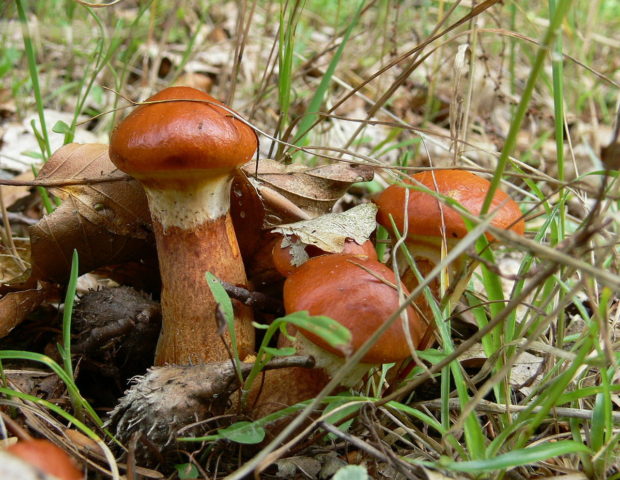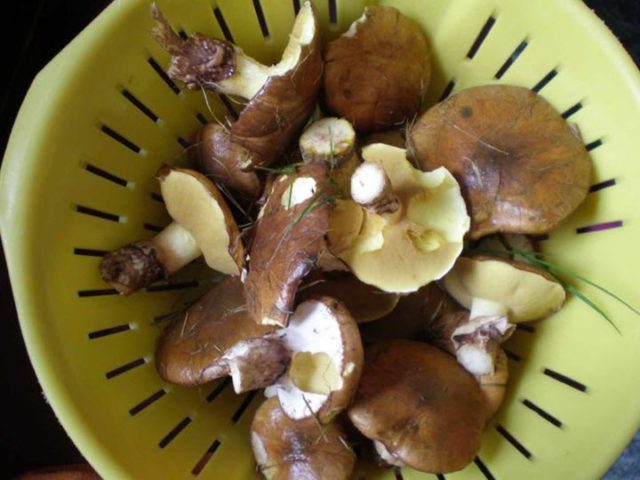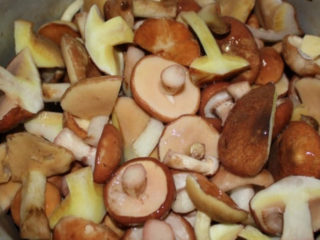Content
The butterdish is remarkable - it is a mushroom of the Boletaceae family. Like all boletus, it has a characteristic feature in the form of a slippery oily cap. The mushroom has become widespread in the Northern Hemisphere, where it grows almost everywhere. Similar to other representatives of the Boletaceae, the remarkable butterdish can be eaten with minimal heat treatment.
Where do the remarkable boletus grow?
The geography of the remarkable oiler's habitat is very extensive.In Eurasia, it can be found almost throughout the entire territory of coniferous forests, from the Ural Mountains to the Far East. There is no place in the Siberian taiga where this mushroom is not found.
In addition, the remarkable oiler feels great in North America - it is distributed from the west to the east of the United States, from the east coast of the Pacific Ocean to the west coast of the Atlantic. The American distribution area of the fungus is limited to Canada from the north, and to the boundary between temperate and subtropical climates from the south.
Like all boletus, this mushroom prefers proximity to coniferous trees, with which it enters into symbiosis in the form of mycorrhiza. The best symbiotic relationship for this type of mushroom is with larches. It is under this tree that you can find the largest colonies of the remarkable butterfly.
The oiler loves moisture very much, so in forests with high humidity (abundance of streams, rivulets and swamps) it can be found more often than in places with a dry climate.
What remarkable boletus look like
The mushroom received its Russian name for its cap with its original color and texture, which attracts the eye. This variety has an attractive appearance, and it is quite difficult to confuse it with other boletus.
The mushroom cap is from 4 to 12 cm in diameter. At the beginning of the growth of the fungus, it has a spherical shape, which later changes to a conical shape, and then to an outstretched one. The mucous surface of the cap has a dark red or brownish-red tint. Throughout the entire area of the cap there are small fragments of various shades of gray.
The hymenophore has a tubular structure of a yellowish color. As the mushroom grows, the color changes to yellow-brown, then completely brown.Pore diameter – no more than 1 mm.
The leg has a length of 3 to 12 cm, and its diameter rarely exceeds 20 mm. The shape of the leg is cylindrical, often hollow inside. The ring, located 2-3 cm from the cap, divides the leg into two zones: the upper, clean, yellow zone and the lower, covered with burgundy scales.
The flesh of the mushroom is yellow. The cut in the fresh air becomes yellow-pink after about 30 minutes, after 3-4 hours the color of the cut changes to brown. The color of the spore powder is yellow-brown.
The appearance of the remarkable oiler is shown in the photo:
Is it possible to eat remarkable boletus?
The remarkable butterdish belongs to the conditionally edible mushrooms. Its relation to this group is due not only to its taste, but to the fact that this type of mushroom is extremely wormy.
To reduce the risks of collecting wormy mushrooms, it is recommended to do it in the first half of their fruiting time - from late June to mid-August.
The taste is remarkable
The mushroom belongs to the third category of edibility, its taste is assessed as satisfactory. The mushroom smell is barely noticeable; during heat treatment it almost completely disappears.
Benefits and harms
The remarkable benefit of buttercup, like all representatives of mushrooms, is its high protein content. This is a high-calorie product that can quickly satisfy hunger.
It should be remembered that eating mushrooms has a number of restrictions and contraindications. Harm from consuming mushrooms can only occur if they are collected in close proximity to roads or railways, as well as industrial enterprises.Remarkable oils tend to accumulate toxins and heavy metal salts, which are almost impossible to remove from them.
In addition, the remarkable butterdish, like all mushrooms, has direct contraindications - it should not be consumed by children under 5 years of age, pregnant women, or people suffering from gastrointestinal diseases.
Collection rules
The fruiting time of the oiler is remarkable - from late June to early October, depending on climatic conditions. The peak of harvesting occurs in the second half of summer, while the fruiting bodies are not yet subject to massive attacks by worms.
The optimal time for collection is considered to be the 2nd or 3rd day after rain, since rain and heavy dew are an excellent growth stimulator.
It is recommended to effectively collect boletus in coniferous or mixed forests. They prefer well-lit areas of the forest: clearings and edges. Mushrooms can often be found along paths and small roads. In the presence of high humidity, they are also found in more shaded places. When collecting, you need to be careful, since most mushrooms are hidden under pine litter.
False doubles oil the remarkable
Remarkable butterflies have several doubles, very similar to them in appearance. The degree of similarity of these mushrooms is so great that it is possible to determine whether it is an oil dish or its double only by cutting them off and carefully examining the structure of the stem and hymenophore.It is very difficult to determine just by the appearance of the cap whether it belongs to one or another type of mushroom in question. However, an error in the definition will not have critical consequences - all of the remarkable butterdish’s doubles are (albeit conditionally) classified as edible.
The main “candidate” for the remarkable butterdish double is the pepper mushroom. It differs from the original in the absence of a ring on the stalk and the red tint of the hymenophore; in butterfish it has a yellow or yellow-brown color.
Another lookalike is the spruce fly. When viewed from the height of human growth, it is also easy to confuse it with a remarkable oil can. Differences appear after cutting and inspection:
- The spruce fly hymenophore is lamellar, not tubular;
- the amount of mucus on the cap is too large, which is not typical for butterfish in general.
Spruce fly is edible (perhaps even more so than the butterdish in question), but it is not valued by Russian mushroom pickers. One of the reasons for such dislike for this mushroom is that its mucus turns other species purple.
Application of remarkable oils
The remarkable butterdish is an almost universal mushroom, since it can be prepared in a variety of ways: dried, fried, boiled, salted, etc. The remarkable butterdish is used to make first and second courses, they are pickled and used to prepare sauces.
At the same time, one should not forget about the mandatory processing of fruiting bodies after collection. It aims not only to protect a person from possible poisoning.If heat treatment is carried out incorrectly, you can completely deprive the product of its taste.
Any processing begins with sorting the collected material: mushrooms are checked and identified so that inedible ones do not accidentally get mixed with edible ones. Next, remove the skin from the caps and wash them well.
After the mushrooms are washed, they must be cut and rinsed again in cold water. The water must drain; it is not recommended that the fruiting bodies be in contact with water for too long after cutting. In this state, they are able to absorb it very well, which can cause them to become inelastic, and their taste also changes in a negative direction.
After the second washing has been carried out, you can begin heat treatment of the fruiting bodies. If mushrooms need to be fried, they are immediately placed in oil in a heated frying pan. If you plan to cook, you need to put the fruiting bodies in cold water and bring to a boil.
Heat treatment lasts no more than 20 minutes. This is how long the fruiting bodies are stewed in a frying pan or kept in boiling water. During this time, no other products are added to them; they must be added to the dish after this period.
Conclusion
The remarkable butterdish has an attractive appearance, but its taste makes it possible to classify it as conditionally edible. The remarkable oiler mainly grows in damp coniferous forests, preferring proximity to larches. Its collection time falls in the second half of summer.This variety has universal application; it is consumed boiled, stewed, fried and salted.


















